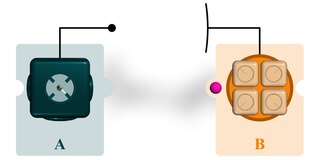
In cryptography, the one-time pad (OTP) is an encryption technique that cannot be cracked, but requires the use of a single-use pre-shared key that is larger than or equal to the size of the message being sent. In this technique, a plaintext is paired with a random secret key. Then, each bit or character of the plaintext is encrypted by combining it with the corresponding bit or character from the pad using modular addition.

Quantum information is the information of the state of a quantum system. It is the basic entity of study in quantum information theory, and can be manipulated using quantum information processing techniques. Quantum information refers to both the technical definition in terms of Von Neumann entropy and the general computational term.

Quantum teleportation is a technique for transferring quantum information from a sender at one location to a receiver some distance away. While teleportation is commonly portrayed in science fiction as a means to transfer physical objects from one location to the next, quantum teleportation only transfers quantum information. The sender does not have to know the particular quantum state being transferred. Moreover, the location of the recipient can be unknown, but to complete the quantum teleportation, classical information needs to be sent from sender to receiver. Because classical information needs to be sent, quantum teleportation cannot occur faster than the speed of light.
Quantum key distribution (QKD) is a secure communication method that implements a cryptographic protocol involving components of quantum mechanics. It enables two parties to produce a shared random secret key known only to them, which then can be used to encrypt and decrypt messages. The process of quantum key distribution is not to be confused with quantum cryptography, as it is the best-known example of a quantum-cryptographic task.
In cryptography and computer security, a man-in-the-middle (MITM) attack, or on-path attack, is a cyberattack where the attacker secretly relays and possibly alters the communications between two parties who believe that they are directly communicating with each other, as the attacker has inserted themselves between the two user parties.

Alice and Bob are fictional characters commonly used as placeholders in discussions about cryptographic systems and protocols, and in other science and engineering literature where there are several participants in a thought experiment. The Alice and Bob characters were invented by Ron Rivest, Adi Shamir, and Leonard Adleman in their 1978 paper "A Method for Obtaining Digital Signatures and Public-key Cryptosystems". Subsequently, they have become common archetypes in many scientific and engineering fields, such as quantum cryptography, game theory and physics. As the use of Alice and Bob became more widespread, additional characters were added, sometimes each with a particular meaning. These characters do not have to refer to people; they refer to generic agents which might be different computers or even different programs running on a single computer.
Quantum networks form an important element of quantum computing and quantum communication systems. Quantum networks facilitate the transmission of information in the form of quantum bits, also called qubits, between physically separated quantum processors. A quantum processor is a machine able to perform quantum circuits on a certain number of qubits. Quantum networks work in a similar way to classical networks. The main difference is that quantum networking, like quantum computing, is better at solving certain problems, such as modeling quantum systems.
BB84 is a quantum key distribution scheme developed by Charles Bennett and Gilles Brassard in 1984. It is the first quantum cryptography protocol. The protocol is provably secure assuming a perfect implementation, relying on two conditions: (1) the quantum property that information gain is only possible at the expense of disturbing the signal if the two states one is trying to distinguish are not orthogonal ; and (2) the existence of an authenticated public classical channel. It is usually explained as a method of securely communicating a private key from one party to another for use in one-time pad encryption. The proof of BB84 depends on a perfect implementation. Side channel attacks exist, taking advantage of non-quantum sources of information. Since this information is non-quantum, it can be intercepted without measuring or cloning quantum particles.

ID Quantique (IDQ) is a Swiss company, based in Geneva, Switzerland, and provides quantum key distribution (QKD) systems, quantum safe network encryption, single photon counters, and hardware random number generators.
Entanglement distillation is the transformation of N copies of an arbitrary entangled state into some number of approximately pure Bell pairs, using only local operations and classical communication.
Quantum cryptography is the science of exploiting quantum mechanical properties to perform cryptographic tasks. The best known example of quantum cryptography is quantum key distribution, which offers an information-theoretically secure solution to the key exchange problem. The advantage of quantum cryptography lies in the fact that it allows the completion of various cryptographic tasks that are proven or conjectured to be impossible using only classical communication. For example, it is impossible to copy data encoded in a quantum state. If one attempts to read the encoded data, the quantum state will be changed due to wave function collapse. This could be used to detect eavesdropping in quantum key distribution (QKD).
The noisy-storage model refers to a cryptographic model employed in quantum cryptography. It assumes that the quantum memory device of an attacker (adversary) trying to break the protocol is imperfect (noisy). The main goal of this model is to enable the secure implementation of two-party cryptographic primitives, such as bit commitment, oblivious transfer and secure identification.
Within quantum cryptography, the Decoy state quantum key distribution (QKD) protocol is the most widely implemented QKD scheme. Practical QKD systems use multi-photon sources, in contrast to the standard BB84 protocol, making them susceptible to photon number splitting (PNS) attacks. This would significantly limit the secure transmission rate or the maximum channel length in practical QKD systems. In decoy state technique, this fundamental weakness of practical QKD systems is addressed by using multiple intensity levels at the transmitter's source, i.e. qubits are transmitted by Alice using randomly chosen intensity levels, resulting in varying photon number statistics throughout the channel. At the end of the transmission Alice announces publicly which intensity level has been used for the transmission of each qubit. A successful PNS attack requires maintaining the bit error rate (BER) at the receiver's end, which can not be accomplished with multiple photon number statistics. By monitoring BERs associated with each intensity level, the two legitimate parties will be able to detect a PNS attack, with highly increased secure transmission rates or maximum channel lengths, making QKD systems suitable for practical applications.
Quantum Experiments at Space Scale, is a Chinese research project in the field of quantum physics. QUESS was launched on 15 August 2016.
The six-state protocol (SSP) is the quantum cryptography protocol that is the version of BB84 that uses a six-state polarization scheme on three orthogonal bases.
Consider two remote players, connected by a channel, that don't trust each other. The problem of them agreeing on a random bit by exchanging messages over this channel, without relying on any trusted third party, is called the coin flipping problem in cryptography. Quantum coin flipping uses the principles of quantum mechanics to encrypt messages for secure communication. It is a cryptographic primitive which can be used to construct more complex and useful cryptographic protocols, e.g. Quantum Byzantine agreement.

The DARPA Quantum Network (2002–2007) was the world's first quantum key distribution (QKD) network, operating 10 optical nodes across Boston and Cambridge, Massachusetts. It became fully operational on October 23, 2003 in BBN's laboratories, and in June 2004 was fielded through dark fiber under the streets of Cambridge and Boston, where it ran continuously for over 3 years. The project also created and fielded the world's first superconducting nanowire single-photon detector. It was sponsored by DARPA as part of the QuIST program, and built and operated by BBN Technologies in close collaboration with colleagues at Harvard University and the Boston University Photonics Center.
Quantum secret sharing (QSS) is a quantum cryptographic scheme for secure communication that extends beyond simple quantum key distribution. It modifies the classical secret sharing (CSS) scheme by using quantum information and the no-cloning theorem to attain the ultimate security for communications.
Quantum robotics is an interdisciplinary field that investigates the intersection of robotics and quantum mechanics. This field, in particular, explores the applications of quantum phenomena such as quantum entanglement within the realm of robotics. Examples of its applications include quantum communication in multi-agent cooperative robotic scenarios, the use of quantum algorithms in performing robotics tasks, and the integration of quantum devices in robotic systems.






